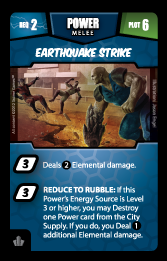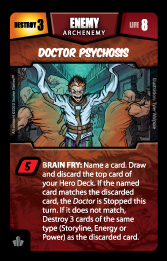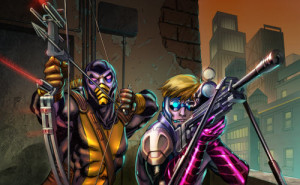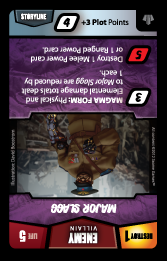We interrupt your regularly scheduled show to report that large swaths of Metro City are now being held hostage by the nefarious Lady Tundra. Her icy touch and icy demeanor are leaving thousands of people in very real danger. If you are in the downtown area, stay indoors and avoid all doors and windows. Local law enforcement are doing all they can, and the Home Guard have been called in to assist them. Authorities are asking that . . . hold on. I’m getting told we have an update from the scene. . . one moment. . .
. . . yes, we are now reporting with new but still unconfirmed reports of multiple hero sightings in the the downtown vicinity, including the Quicksilver Pigeon, Junkyard Ninja, and Epic Jeff. . .
The Premise
Metro City is under attack! A dreaded enemy has besieged the city with their lackeys in tow, and it is up to a heady band of superheroes to fly, leap, and run to the rescue. Which heroes make an appearance is up to the player’s imagination, but they mustn’t wait too long. Danger threatens the citizens of Metro City at every turn, and it’s unlikely the bad guys will up and leave if they’re asked nicely.
The Rules
Heroes of Metro City is a deckbuilding game centered around being superheroes, and the core mechanics are similar to other deckbuilders.
To begin, twelve stacks of cards are placed on the board. These stacks represent the city’s skyline that players are trying to protect. They are also the resources that players attain throughout the game. The cards come in three types: Power, Energy, and Storyline.
- Power cards are skills and abilities that players can acquire as they try to stop evildoers. Powers can be a variety of subtypes, such as Ranged or Melee, and many do damage of one kind or another.
- Energy cards are required for players to be able to use Power cards.
- Storyline cards act as the game’s currency, called Plot Points.
Each player starts the game with five of the basic Energy cards and five basic Storyline cards. Additionally, players choose an additional card or two powers to start with, depending on turn order and the card’s purchase costs.
Players also receives a dry-erase board to give their champion a name and keep track of their powers.
The City cards are attacked via three stacks of Enemy cards, and the topmost card of each stack is revealed to start the game, beginning the siege.
 The first player is determined randomly, but if a dice roll is not sufficient, feel free to make any stipulation you wish, such as “the last person to watch a superhero movie”, or “the last person to read a comic book.”
The first player is determined randomly, but if a dice roll is not sufficient, feel free to make any stipulation you wish, such as “the last person to watch a superhero movie”, or “the last person to read a comic book.”
Turns are played out over a series of steps. First, if the top card of either of the first two Enemy stacks is face-down, reveal it. Then, the player plays Energy and Power cards from their hand. Energy cards are used by putting them in one of four available slots on a player board. Each Energy card provides an Energy Level. Power cards have an Energy Requirement for them to work. As such, Power cards are played on top of Energy cards to enable their effects. For example, Earthquake Strike requires an Energy Level of two slotted to be played.
Once all available Powers for the turn are activated, players unleash their damaging attacks on the foe’s life totals. Enemies come in three categories, each one increasing in difficulty. Players do damage to as many Enemies as they can; if a player delivers enough of a blow to destroy an Enemy, it dies. That card is turned upside-down and can be added to the player’s hand as new Storyline cards. Think of it as gaining experience.
Next, players may purchase a new card for their deck. This is done by playing Storyline cards to generate Plot Points. Every card in the City supply has an associated Plot value, showing how much they cost.
Finally, any remaining Enemies take their turn. Thematically, the game attempts to stay their attack in the form of local Metro City defenses. Players roll a d12 for each remaining Enemy stack. If the player meets or exceeds the required number, the city itself thwarts their attack this turn. Otherwise, the Enemy’s attack happens, as depicted on the cards. Most attacks destroy cards in the City supply, moving them to the trash pile.
If the Archenemy’s attack cannot destroy a card of the required type, they have caused too much devastation to save that part of the city, and the players lose. They give up the cloak and cape, clearly proving that there was nothing actually super about them. Alternatively, if the player manages to defeat the Archenemy, they and their league of heroes emerge victorious.
Otherwise, the player moves all cards played this turn to the discard pile, with the exception of up to one Energy card per slot, and draws a new hand of five cards. It then becomes the next player’s turn to save the day.
Donning the Superhero Mantle
People’s fascination with comic book stories has been around for decades, from the assertive no-nonsense Golden Age progenitors to the Silver Age moral paragons to the rise of complex and often darker Modern Age varieties. They exist as both a source of entertainment and a reflection of society at a given time. As visual pulp fiction, they allow people to explore concepts that are far trickier in real life while still providing an outlet of those topics, be it as a critique of affairs, or exploring possible futures. Does good always triumph over evil? Are the superheroes of our tales so super? And is it really that simple? Comic characters now exist in many forms besides ink and pencil, including gaming.
However, not everyone wants to play an established character. Adding in licensed characters hampers the scope of what a person can do when playing a game, either creatively or expressively. In Heroes of Metro City, you do not have that issue. Here people don’t have to pretend to be The Hulk or The Flash. Instead, players get to be as imaginative as they want. They can take on the game’s enemies as The Wombat, Captain Carnie, or General Beatdown. Heroes of Metro City invites players to take whatever tact they want, to be as goofy or as serious as they desire. Daredevils, this is your kind of playground.
This is reflected in a number of places, from the name choice, to the variety of powers, to the artwork itself. It’s evident from the great swath of artistry on the cards that the designers went to great length to include many different comic book art styles, rather than try to enforce a specific one. You never feel like you’re planted in a specific comic. (We imagine a DC fan stuck in the Marvel universe would involve much weeping.) What’s more, rather than forcing specific narratives, the game provides you with a host of powers to choose from. Whether you want a technological hero, a hand-to-hand fighter, or a force of nature, the only limit is which card stacks are in each game. It’s an understatement to say that no two games of Heroes of Metro City will ever be alike. For comic-friendly Immersionists, or even just roleplayers in general Heroes is sure to provide an outlet for you.
95% Co-Op
Mechanically speaking, Heroes of Metro City follows a similar pattern to most deckbuilders. That is, there are randomly assorted cards that players can add to their deck through one mechanism or another. Simply just left it there, however, and you would merely have a comic book reskin of Dominion. Heroes takes that model and adds in three additional components that really let the game stand on its own:
#1. It’s a Co-Op. Mostly.
Most deckbuilding games let players sculpt their own deck largely unfettered by the actions of others. On the one hand, it lets players work towards a purpose without worrying about other players, and if they do want confrontation, it’ll be on their terms. This style is the bailiwick of civ-building Architects, and it explains why they usually enjoy these type of games. On the other hand, the chief complaint lobbied against deckbuilders is that this approach decreases player engagement. Heroes of Metro City, by opting for a Co-Op approach, avoids this. Instead of individual players engaging in a battle of wits, you are actively working with one another to defeat the game bosses. Players discuss strategies over which cards they should spare versus which to destroy, what powers they should specialize in, and so on.
That said, even with a collective goal in mind, every player (ideally) is going to portray different superheroes. You’re still able to tailor your choices to your own style. Tacticians, suit up.
Interestingly because of the Co-Op factor, it’s also plausible for Socializers to give the game a chance. Deckbuilders are hit-or-miss with this group, and although there are tactical decisions that need to be made, turns are fairly quick, the bad guys are semi-automated, and there’s plenty of room for geeky superhero banter with other players. Still, they should be aware that the game does take a few rounds get going, and like any deckbuilder, it’s not uncommon in the early-to-mid stages to have hands where you can do very little.
As to why only a ‘95% Co-Op’? Purely flavor reasons. Any superhero ensemble ever has shown that while the common cause is the main objective, egos still play a factor. When the Archenemy is defeated, everyone wins. It’s just, well, don’t you want to be the one to do it?
#2. Enemies as a resource
When you defeat the Archenemy’s flunkies, their card now becomes part of your resume as Storyline Cards instead of becoming excess cards in your deck or being removed for arbitrary points. You have grown as a superhero, and the experience of defeating something like Trained Agents nets you the experience needed to develop new skills. The transition of these cards from obstacle to currency propels the game along both mechanics-wise and story-wise. Heroes of Metro City wisely doesn’t use a VP strategy: it uses an XP strategy.
#3. Dual Purpose Card Supply
Depicting stacks of cards as a cityscape works on more than an imaginative level. In Heroes, the measure of your success or failure is directly tied into the availability of those cards. Enemies are constantly going to be destroying cards, and players need many of those same cards for their decks. It creates a wonderfully tied-in system that escalates tension the longer it goes. Players have to discuss what cards are worth keeping versus what are worth sacrificing. You know, for the greater good.
Not Immune to Kyrptonite
For all of the things that Heroes of Metro City does correctly, though, there are a couple minute chinks in the armor.
For one, the cards need to be sleeved for long-term usage, as they are slightly thinner than even comparable deckbuilders. The silver lining is that rest of the components are great, and the box tray was even designed to be capable of holding sleeved cards.
There are also a couple areas players could feel stymied with inconsistent luck and tempo. There may be times early on when players have unproductive hands. This can be disheartening when other players are met with success on their side. Strikers will like pitting their superhero prowess up against their teammates, but their excitement could diminish if they feel comparatively stuck. Heroes tries to offset that by letting players get some Power cards right from the onset, but that advantage can easily be erased by poor choices and unlucky draws.
The Takeaway
Heroes of Metro City is what you would get if you combined Dominion with The Incredibles. From the fanciful artwork to the well-organized and easy to follow rules, Heroes is the product of some super effort. The interconnectedness between the game’s theme and its mechanics is impressive – it succeeds handily in imparting the feeling of the players attempting to save the city from the clutches of the bad guys. As with any deckbuilder, there will be some unfortunate hand draws, and the game’s tempo can vary from session to session, but its team-oriented nature prevents players from getting permanently sidelined. Heroes of Metro City is a fitting tribute to the superhero genre it represents, although you don’t even have to be a fan of the source material for it to be worthwhile. When you’re out on patrol for new games, Metro City is certainly one place for you to consider.
Cardboard Republic Snapshot Scoring (Based on scale of 5):
Artwork: 4
Rules Clarity: 5
Replay Value: 4
Physical Quality: 3.5
Overall Score: 4.5
Photo Credits: Superhero cards and artwork by 3Some Games.




